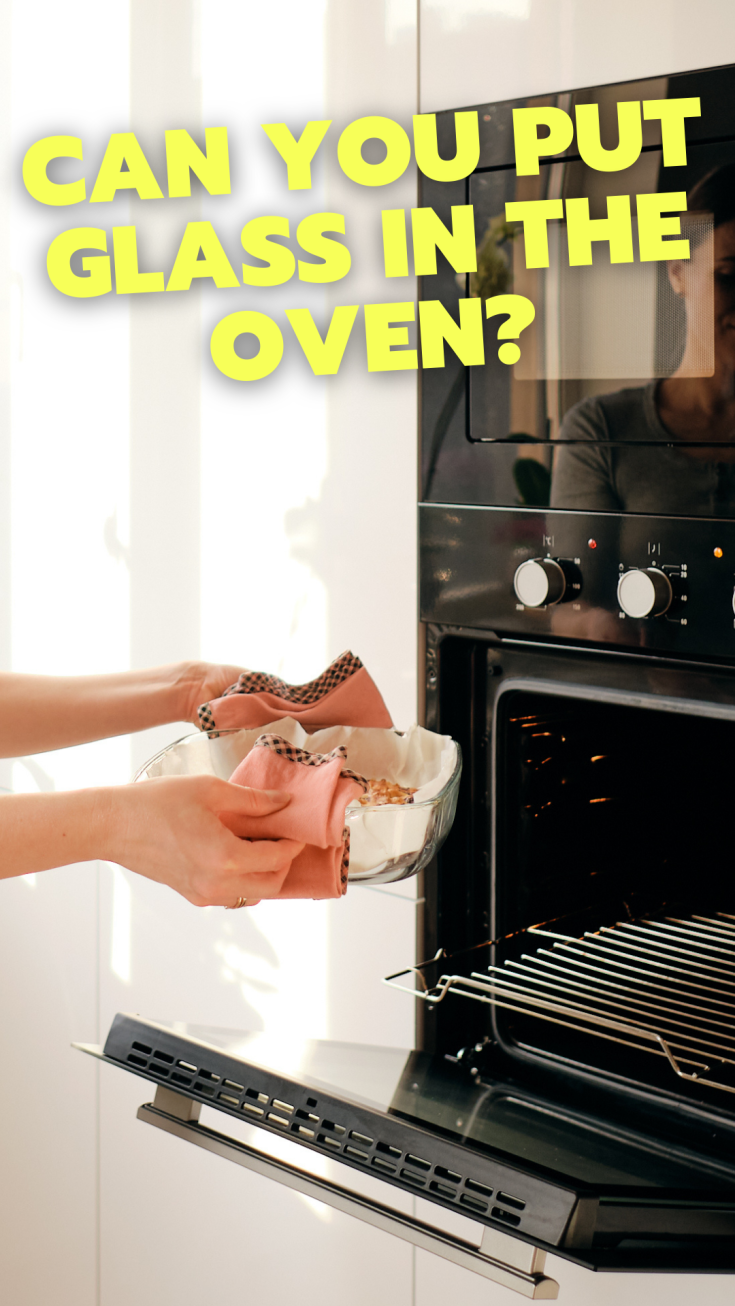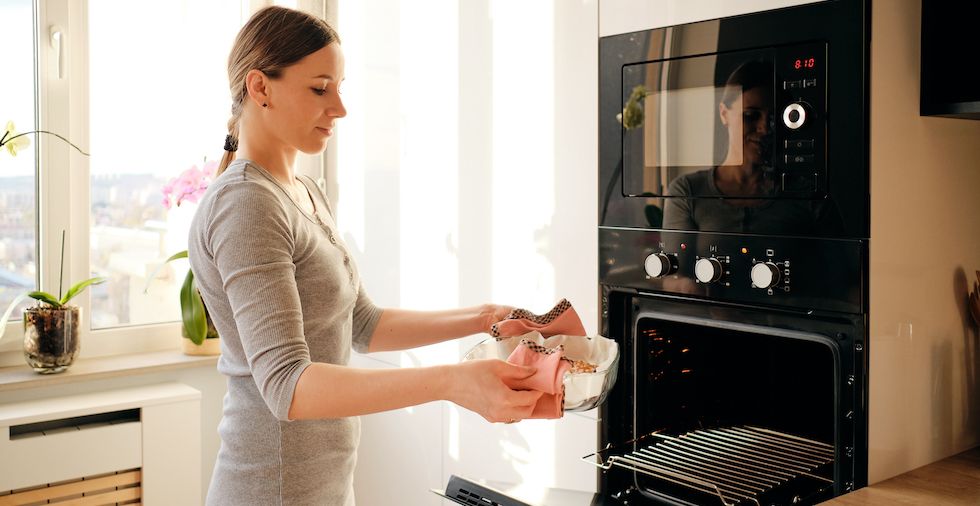- Can you put glass in the oven?
- How can you tell if the glass is oven-safe?
- How to use oven-safe glassware
The mysteries of the kitchen are plentiful. Whether you’re a seasoned chef or a newbie cook, there are some basic rules you need to get your head around. It’s kitchen tips 101.
For example, when you’ve whipped up a delicious meal for the family—and you’ve got leftovers—how can you reheat them? Popping the glass dish, Tupperware, or plate in the oven might seem like a no-brainer. But is it safe? Make the wrong move here, and you could end up with more than a mess. You could end up with a safety hazard.
Luckily, we’ve got you covered. In this complete guide, we will answer the question “can you put glass in the oven” and give you some handy tips to help you along the way.
Can you put glass in the oven?
Before you turn up the heat and start, you need to know the facts. So, let’s outline what you need to know: Not all glassware is oven-safe.
Assuming that it is could be extremely dangerous. However, certain glass products, such as Pyrex bowls and casserole dishes, might be heat resistant up to a specific temperature. For example, tempered glass tends to be safe to use in the oven. According to Scientific American, this type of glass is four times stronger than ‘ordinary’ glass. That’s because tempered glass shatters into small and insignificant pieces rather than large shards.
So, how is tempered glass made? Good question. While you don’t need to understand all the ins and outs of tempered glass, the simple explanation is that it undergoes a heat treatment followed by a swift cooling process called ‘quenching’. The latter treatment only takes a few seconds and involves high-pressure air directed at the glass. The result is that the centre of the glass holds tension while the outer layer remains in compression.
While tempered glass is far more robust than regular glassware, you always need to do your homework. Don’t make assumptions about a specific glass product being safe to use in the oven. Instead, check out each piece of glassware first.
How can you tell if the glass is oven-safe?
Now that you know about different types of glass, let’s talk about how you can tell if your product is oven safe. Whether you’re using ramekins, plates, dishes, Tupperware, or pans, there are a few ways that you can check things out. Figuring out if you have safe glass cookware at home needn’t be a hassle. Here are three tricks you can use to test it.
1. Check for the oven-safe symbol
First things first, you want to check if the glassware has an oven-safe symbol on it. For example, let’s say that you have a glass baking dish that you want to pop in the oven. However, before doing that, take a moment to inspect the product to see whether it has any symbols. Often enough, you will find that these symbols are engraved on the product’s underside.
But, "what is the oven-safe symbol?", we hear you ask. The oven-safe symbol is a bowl inside an oven with heatwaves going upwards. However, not all oven-safe glassware products will sport this particular sign, which is not universally recognised. For example, if your glassware comes from abroad, it may have a different symbol on it altogether. You may also see variations of the emblem or even simple text saying ‘oven-safe product’. So check it out as your first port of call.
2. Check the user guide of manual
Are you using a new glass product? If you’ve recently bought the item, you may have the user guide or manual hiding away in a drawer. That’s good news! You can check this literature to see whether the glassware can be used in the oven. In some cases, you will find that instructions explain how to heat the glassware products.
3. Use the power of Google
If you have an older glassware product, there’s a last resort: Google. If you know the brand of the product—for example, if it’s Pyrex—you can check the company website. Of course, it may take you some time to find the exact product on their site. However, if you are lucky enough to get it right, you should see all the information you need.
How to use oven-safe glassware
So, you’ve figured out that your glassware is oven-safe? Exciting. Now that you know you can use the glass products in your oven, there are some extra things to keep in mind. Understanding the golden rules here will mean that you don’t make any rookie errors. Here are five other things that you need to keep in mind:
- Always read the instructions first (if you have them!)
- Avoid putting super cold glass in the oven.
- Don’t put hot glassware straight into the dishwasher.
- Take care when removing glass from the oven.
- Don’t put hot glassware directly on the kitchen surface.
The above tips will help you keep your glassware, kitchen, and family safe. What more could you want? When you’ve learned them, you can reheat all your favourite leftovers without ever having to worry. Who said modern life had to be hard, eh?
Now that you've read our guide to which types of glass are oven-safe, you might be wondering can you microwave glass? Find out in our other article.
Q&A
Now that you know all about heating glassware in your oven, let’s take a moment to answer some frequently asked questions. Here are some essential things you need to know regarding the age-old issue of glass and heat. Enjoy!
At what temperature does glass break in the oven?
The answer depends on the type of glass you are using. For that reason, you should always check the manufacturer’s guidelines before putting glass in the oven. You may find that thin glass will break at around 150-200°C. However, thicker, oven-ready glassware may be able to withstand hotter temperatures. Never take anything for granted here.
Does glass explode in heat?
Glass is a durable material. That means that it should not explode in natural heat. For example, if you leave some glassware in the summer sun, you should find it heats up without getting too hot to remain sturdy. On the other hand, many types of glassware are not made to withstand unnatural heat, such as that from an oven. When this glass gets too hot, you may find that it undergoes a thermal break and can explode.
Can you put Pyrex glass in the oven?
While many people presume that Pyrex can withstand any heat, that is not always the case. According to Consumer Reports, if you cool or heat a Pyrex product too quickly, it can put pressure and stress on the material’s structure. In extreme cases, this move can cause the product to become fractured and even explode. For that reason, you need to make sure that you check the instruction guide or manual when buying products.
Can you put a glass lid in the oven?
If you have a glass lid that you use for pots and pans, the chances are that you can safely put it in the oven. The reason is that these types of covers tend to be made of durable and thick glass that can withstand temperatures of around 200°C. As always, you may want to check the product information, such as the instructions or user guide.
Can you put glass in all oven types?
Maybe, but you need to make sure that the glassware is heat resistant. Whether it’s a baking dish, a glass plate, or even ramekins, you need to know that the product is made from ovenproof glass. You should take a close look at the product to gain this information.
Can you put a shot glass in the oven?
Are you heating some mini desserts? You might think that shot glasses are the ideal vessels. However, most shot glasses are likely to be thin glass that can break easily. With that in mind, it is unlikely that you can put these glasses in the oven at a high temperature.
Are glass pans oven-safe?
While most glass pans will be oven-safe, you shouldn’t take this for granted. If the pans are made of heat resistant glass, you will be able to put them in a convection oven, a toaster oven, or even a microwave oven. Look for the oven-safe symbol before you use these products. That way, you will avoid any accidental explosions.
Can you put a drinking glass in the oven?
Drinking glasses—and even glass coffee mugs—are not made for oven use. That means that you should avoid putting this glassware in any oven. In addition, it is likely that these glasses are thin, which means that they are susceptible to breakages. Keep yourself and your glassware safe by using a different vessel for the job.
Is it ok to heat cold glass?
If you keep a glass plate or dish in the fridge, you might want to think twice before whacking it in the oven or microwave. The quick change from cold to hot could put a lot of pressure on the material, causing it to break or even shatter.
We hope you found this article helpful! Leave a comment if you have any questions.


Hi. I am a new owner of a convection oven and really appreciate your information on how to use it so thanks so much for your time. Appreciate it!! gayle rush
You're very welcome, Gayle!